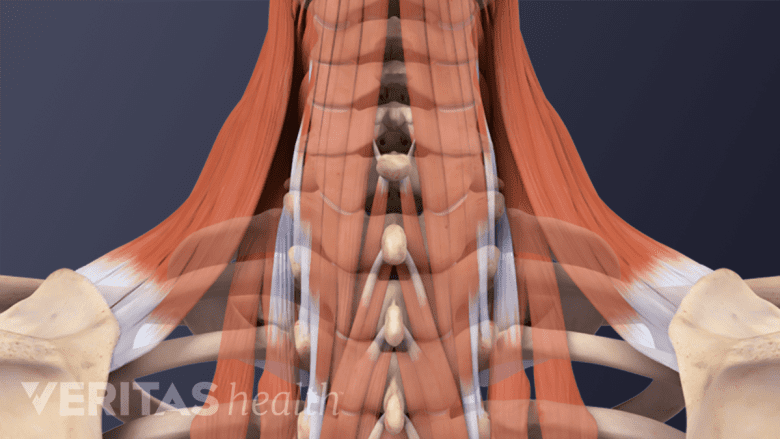Fibromyalgia is a syndrome typically known for causing widespread pain, tenderness, fatigue, and mental health challenges. While the symptoms and severity of fibromyalgia can vary greatly, neck pain and stiffness are commonly experienced.
The cause of fibromyalgia is still unknown, but the syndrome is better understood by doctors today compared to several years ago. When people with fibromyalgia receive an accurate diagnosis and start treatment, the condition can usually be managed well enough to experience an improved quality of life.
In This Article:
Common Symptoms
Common symptoms of fibromyalgia include searing pain on both sides of the body, including the neck.
The onset of fibromyalgia is typically gradual. Common symptoms can include:
- Widespread pain. The pain is in all four quadrants of the body—upper left, upper right, bottom left, and bottom right. It can range anywhere from mild aches to intense, searing pain. There are points throughout the body (including on each side of the neck) that are tender to the touch and can refer pain to other parts of the body.
- Chronic fatigue. This persistent tiredness could include consistently waking up in the morning and not feeling refreshed, needing to take more naps than usual, and not being able to maintain a normal daily routine, such as participating in fewer social activities or getting fewer tasks done. Complicating matters, fibromyalgia can make it harder to fall asleep and stay asleep for a full night’s rest.
- Problems with cognition. There could be difficulty with staying focused and/or remembering things.
- Mood disorders. Whether triggered by the stress and challenges of fibromyalgia, or an associated chemical imbalance, it is common to also experience depression and/or anxiety. A full list of fibromyalgia symptoms is beyond the scope of this article, and there can be a wide variety in the intensity of symptoms from person to person.
Read more about Fibromyalgia Symptoms on Arthritis-health.com
How Fibromyalgia Causes Neck Pain
In addition to pain, stiffness, and fatigue, fibromyalgia causes tender points throughout the body.
The exact mechanisms for how fibromyalgia causes pain—including neck pain—are still being studied. For example, some studies have suggested that people with fibromyalgia receive less blood flow and/or oxygen to their muscles, which could play a role in the pain. Additionally, a 2013 study found that a subset of fibromyalgia patients actually had some measurable nerve damage in areas that were painful.1Oaklander AL, Herzog ZD, Downs HM, Klein MM. Objective evidence that small-fiber polyneuropathy underlies some illnesses currently labeled as fibromyalgia. Pain. 2013;154(11):2310-6.
What is known is that 18 common tender points have been identified in specific areas of the body. Almost half of these tender points are clustered in four regions: the neck, base of the head, shoulders, and upper back. While pain may not be experienced in all 18 tender points, it is highly likely that neck pain will be one symptom, either as pain that originates in the neck or is referred to the neck.
Diagnosis
Fibromyalgia can take a relatively long time to diagnose because symptoms tend to come and go, and other conditions must first be ruled out. According to guidelines from the American College of Rheumatology, getting an accurate diagnosis for fibromyalgia typically involves the following:
- Gather specifics regarding pain in the past week, as well as fatigue, waking unrefreshed, and difficulty with concentration or memory.
- Determine whether the symptoms have lasted at a noticeable level for at least 3 months.
- Take diagnostic tests, such as a blood test, to see if a rheumatic disease or other conditions could be the culprit.
If several common fibromyalgia symptoms have lasted for at least 3 months, and all other possibilities are ruled out, the official diagnosis is fibromyalgia.
Read more about How to Get a Fibromyalgia Diagnosis on Arthritis-health.com
Treatment for Neck Pain from Fibromyalgia
Fibromyalgia cannot be cured, so the focus of treatment is to help control the symptoms. Many treatment options are available, and most patients go through significant amounts of trial and error before finding which ones work best for them. Some common treatment options for fibromyalgia—and its related neck pain—include:
Regular exercise
Aerobic exercise boosts blood flow, aids healing, and reduces stress in the neck muscles.
Staying active every day—such as with walking, aerobic exercises, yoga, and other activities to get the heart pumping and improve strength and flexibility—has been shown to reduce pain from fibromyalgia. However, due to the fatigue factor of fibromyalgia, it is important to start out slowly and focus more on consistency. Exercising a little bit each day in the beginning and then gradually building up from there is recommended.
See Fibromyalgia Exercises on Arthritis-health.com
Prescription medication
The FDA has approved three drugs to specifically treat fibromyalgia: pregabalin (Lyrica), duloxetine hydrochloride (Cymbalta), and milnacipran HCl (Savella). Other medications may also be prescribed depending on the patient’s unique situation.
See Fibromyalgia Medications on Arthritis-health.com
Cognitive behavioral therapy
Meeting with a certified mental health counselor regularly on a short-term basis helps some patients to think about their condition in a more constructive manner. New strategies for finding pain relief and improving quality of life can also be learned.
See Cognitive Behavioral Therapy on Arthritis-health.com
Alternative therapies
Some people find relief from nontraditional treatments, such as neck and back massages, manual manipulation, acupuncture, and others.
It should also be noted that common over-the-counter medications, such as acetaminophen (Tylenol) and nonsteroidal anti-inflammatory drugs (NSAIDs), are not effective for reducing neck pain from fibromyalgia.
- 1 Oaklander AL, Herzog ZD, Downs HM, Klein MM. Objective evidence that small-fiber polyneuropathy underlies some illnesses currently labeled as fibromyalgia. Pain. 2013;154(11):2310-6.








